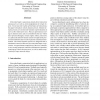Free Online Productivity Tools
i2Speak
i2Symbol
i2OCR
iTex2Img
iWeb2Print
iWeb2Shot
i2Type
iPdf2Split
iPdf2Merge
i2Bopomofo
i2Arabic
i2Style
i2Image
i2PDF
iLatex2Rtf
Sci2ools
ACHI
2009
IEEE
2009
IEEE
Networked Haptic Cooperation Using Remote Dynamic Proxies
Networked haptic cooperation entails direct interaction among users as well as joint manipulation of virtual objects. To increase the realism of both types of interactions, this paper introduces remote dynamic proxies. Remote dynamic proxies are second order dynamic representations of users at the remote peer sites. They are generated according to dynamics laws and are controlled by the user whom they represent through a virtual coupler. Hence, they move in a physically intuitive manner and do not suffer from position discontinuities due to network packet transmission limitations. The remote dynamic proxies are integrated into a distributed control architecture for networked haptic cooperation. An experimental comparison of the new controller to two recently proposed controllers demonstrates smoother rendering of contact between users, as well as stable cooperation for larger network delays.
ACHI 2009 | Haptic Cooperation Entails | Human Computer Interaction | Networked Haptic Cooperation | Remote Dynamic Proxies |
| Added | 18 May 2010 |
| Updated | 18 May 2010 |
| Type | Conference |
| Year | 2009 |
| Where | ACHI |
| Authors | Zhi Li, Daniela Constantinescu |
Comments (0)

